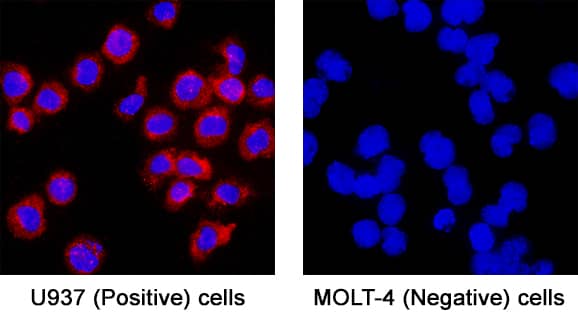Human CD14 Biotinylated Antibody
R&D Systems, part of Bio-Techne | Catalog # BAF383

Key Product Details
Species Reactivity
Validated:
Cited:
Applications
Validated:
Cited:
Label
Antibody Source
Product Specifications
Immunogen
Thr20-Cys352
Accession # P08571
Specificity
Clonality
Host
Isotype
Scientific Data Images for Human CD14 Biotinylated Antibody
CD14 in Human Lymph Node.
CD14 was detected in immersion fixed paraffin-embedded sections of human lymph node using 10 µg/mL Sheep Anti-Human CD14 Biotinylated Antigen Affinity-purified Polyclonal Antibody (Catalog # BAF383) overnight at 4 °C. Tissue was stained with the Anti-Sheep HRP-AEC Cell & Tissue Staining Kit (red; CTS020) and counterstained with hematoxylin (blue). View our protocol for Chromogenic IHC Staining of Paraffin-embedded Tissue Sections.Detection of CD14 in THP-1 (Positive) and MOLT-4 (Negative).
CD14 was detected in immersion fixed THP-1 human acute monocytic leukemia cell line (Positive) and absent in MOLT-4 human acute lymphoblastic leukemia cell line (Negative) using Sheep Anti-Human CD14 Biotinylated Antigen Affinity-purified Polyclonal Antibody (Catalog # BAF383) at 5 µg/mL for 3 hours at room temperature. Cells were stained using the NorthernLights™ 557-conjugated Streptavidin (red; Catalog # NL999) and counterstained with DAPI (blue). Specific staining was localized to cell surface. View our protocol for Fluorescent ICC Staining of Non-adherent Cells.Detection of CD14 in U937(Positive) and MOLT-4 (Negative).
CD14 was detected in immersion fixed U937 human histiocytic lymphoma cell line (Positive) and absent in MOLT-4 human acute lymphoblastic leukemia cell line (Negative) using Sheep Anti-Human CD14 Biotinylated Antigen Affinity-purified Polyclonal Antibody (Catalog # BAF383) at 5 µg/mL for 3 hours at room temperature. Cells were stained using the NorthernLights™ 557-conjugated Streptavidin (red; Catalog # NL999) and counterstained with DAPI (blue). Specific staining was localized to cell surface. View our protocol for Fluorescent ICC Staining of Non-adherent Cells.Applications for Human CD14 Biotinylated Antibody
Immunohistochemistry
Sample: Immersion fixed THP-1 human acute monocytic leukemia cell line (Positive), MOLT-4 human acute lymphoblastic leukemia cell line (Negative) and U937 human histiocytic lymphoma cell line (Positive).
Western Blot
Sample: Recombinant Human CD14 (Catalog # 383-CD)
Human CD14 Sandwich Immunoassay
Reviewed Applications
Read 2 reviews rated 5 using BAF383 in the following applications:
Formulation, Preparation, and Storage
Purification
Reconstitution
Formulation
Shipping
Stability & Storage
- 12 months from date of receipt, -20 to -70 °C as supplied.
- 1 month, 2 to 8 °C under sterile conditions after reconstitution.
- 6 months, -20 to -70 °C under sterile conditions after reconstitution.
Background: CD14
CD14 is a 55 kDa cell surface glycoprotein that is preferentially expressed on monocytes/macrophages. The human CD14 cDNA encodes a 375 amino acid (aa) residue precursor protein with a 19 aa signal peptide and a C-terminal hydrophobic region characteristic for glycosylphosphatidyinositol (GPI)-anchored proteins. Human CD14 has four potential N-linked glycosylation sites and also bears O-linked carbohydrates. The amino acid sequence of human CD14 is approximately 65% identical with the mouse, rat, rabbit, and bovine proteins. CD14 is a pattern recognition receptor that binds lipopolysaccharides (LPS) and a variety of ligands derived from different microbial sources. The binding of CD14 with LPS is catalyzed by LPS-binding protein (LBP). The toll-like-receptors have also been implicated in the transduction of CD14-LPS signals. Similar to other GPI-anchored proteins, soluble CD14 can be released from the cell surface by phosphatidyinositol-specific phospholipase C. Soluble CD14 has been detected in serum and body fluids. High concentrations of soluble CD14 have been shown to inhibit LPS-mediated responses. However, soluble CD14 can also potentiate LPS response in cells that do not express cell surface CD14.
References
- Wright, S.D. et al. (1990) Science 249:1431.
- Pugin, J. et al. (1993) Proc. Natl. Acad. Sci. USA 90:2744.
- Beutler, B. (2000) Current Opinion in Immunology 12:20.
- Stelter, F. (2000) Chem. Immunol. 74:25.
Alternate Names
Gene Symbol
UniProt
Additional CD14 Products
Product Documents for Human CD14 Biotinylated Antibody
Product Specific Notices for Human CD14 Biotinylated Antibody
For research use only


